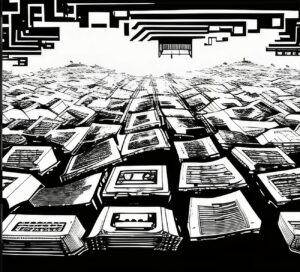Blockchain Voting: The Future of Elections?
In our past articles, we’ve explored how blockchain technology and NFTs hold the potential to shape the future, elevating user experiences across myriad industries. However, today’s topic carries an urgency unlike any other; it’s about voting, a sphere where immediate implementation of blockchain is fervently desired.
Voting is a crucial right, especially in societies cherishing the principles of democracy and liberty. This practice allows ordinary citizens to influence decisions that sculpt their lives directly, underscoring the significance of political engagement. Interestingly, the Ancient Greeks would have considered someone uninterested in politics an “idiot.”
Yet, global voting systems seem stuck in time, plagued by loopholes and imperfections. According to research, America ranked worse among Western democracies. Despite technological advances, our voting procedures have largely remained stagnant, as if those in power prefer to maintain control by retaining outdated systems.
The contentious 2020 US Presidential Election brought these flaws into the spotlight, prompting people to question the integrity of the voting system and contemplate better ways to ensure their votes indeed count. The subsequent four years highlighted how election outcomes directly shape a nation’s policies. As we approach the pivotal 2024 US Presidential Election, the race promises to be fiercer, with the eventual winner poised to impact international relations significantly.
I envision blockchain voting as a solution that can transform this landscape. It promises a more efficient voting process, a fairer campaign environment, and increased trust in outcomes. The transparent and secure nature of blockchain voting means that every aspect of the procedure can withstand scrutiny, making election results indisputable, regardless of the victor.
Join me as we delve into this topic and explore why blockchain voting is the reform we urgently need in our current voting system!
Pain Points in Current Voting System
1. Cost of Voting
Voter turnout is a key way to tell if an election is successful. Over the years, more people have been voting, but we still don’t see 80% of people voting. Interestingly, older people tend to vote more. Why is this happening? It’s all about the ‘cost’ of voting.
First, some people live far away from where they can vote. This means they have to travel a long way to cast their vote. Second, people often have to wait in long lines to vote, which can take hours. These hurdles might seem small because we’re used to them. But isn’t it odd that we can do so many things online but not vote?
Imagine how many more people might vote if we made it more accessible and less time-consuming. This could really boost our democracy. But the lack of change in our voting practices raises questions: are the people in charge happy with how things are, or are they trying to keep things the same?
2. Credibility
Here’s a simple question: why, in the 2020s, do we still count votes by hand? Why do we need to vote in person to show we’re honest, but we also allow voting by mail? Worse, there’s no solid system to ensure the votes are counted right. There’s no check to make sure the vote counters can be trusted. The current system allows too much human error and needs strong steps to ensure it’s trustworthy. We can clearly see these problems, but it seems like no one is trying to fix them.
3. Accountability
Consider this: for essential aspects of our society, we have strict checks and balances in place. Think about company audits where every penny is accounted for or detailed tax forms we fill out. Hence, the government gets every cent due. But strangely, when it comes to voting, a process where we can directly influence our nation’s course, we hardly find a way to verify the results. Our voting system doesn’t provide sufficient accountability. Once the votes are counted and the results declared, it’s done. A recount requires court intervention, which in itself hinges on the court’s decision. We, as citizens, can’t check the results ourselves, and worse, we don’t even have access to the data or information needed for a review. And even if a recount is ordered, if the same people are involved, using the same counting methods, doesn’t that defeat the purpose of a recount?
4. Immediacy
As discussed, our current voting system is not a speedy process. Even though voting typically spans just one day, counting those votes can stretch from several hours to a few days, with results from different centers and states trickling in at their own pace. The longer it takes for the final results to be announced, the greater the window of opportunity for potentially manipulative actions. Control of this time window rests primarily with the voting centers. Ideally, a voting system should reflect results instantaneously as each voter casts their vote, drastically reducing the possibility of fraud. While this approach could shift the risk towards cyber-security, it would eliminate opportunities for old-fashioned, in-person fraud at the voting center.
Benefits of Blockchain Voting
1. Identity Verified
Blockchain technology offers an essential feature known as a smart contract. This tool is remarkable because it guarantees a particular result whenever specific conditions are met. For instance, it can control who has access to certain content. Imagine voters each having a unique identity token. This token enables them to access the voting platform to cast their votes. The smart contract’s code ensures that only those with valid tokens — proving their eligibility — can vote. This turns voting into a verifiable process, enhancing the credibility of the results. In simple terms, smart contracts ensure that only people who should be voting can do so, adding a level of trust and security to the voting process.
2. Transparency
In previous discussions, we’ve emphasized citizens’ limited access to the voting process’s inner workings. But what if we could change that? Enter the transparency offered by blockchain technology. By its very nature, blockchain records transactions on a public ledger that everyone can examine equally. So, when votes are cast on a blockchain network, each vote becomes a part of this transparent record.
Of course, the privacy and confidentiality of voters’ choices must be preserved. The solution could be implementing various data visibility levels. For example, everyone could access overall stats like total vote count, results, the age distribution of voters, etc. Meanwhile, more sensitive data could be restricted to certain authorized officials, such as who voted for which candidate. This way, the transparency of the process is maintained without compromising voters’ privacy. Ultimately, the data is always there. It’s about fine-tuning the access level to uphold openness and privacy.
3. Immutability
At times, we’re privileged to review data and information released to the public. Yet, how can we verify that these are factual records, not merely narratives shaped by those in power? In most digital services we use today, records are stashed away in databases that, given the right access, can be infiltrated and altered. This vulnerability is a crucial cybersecurity concern; what if hackers manipulate these records to serve their purposes?
This is where blockchain’s distinct attribute — immutability — comes into play. As soon as a vote is cast, it gets recorded as an irreversible transaction on the blockchain. Anyone granted access can view this transaction, thus cementing a trustworthy record of each voting action.
In essence, the burden of cybersecurity risk shifts to the blockchain itself. But here’s the catch: blockchain systems are generally far more secure and credible than conventional private or public servers that hinge on the service provider’s security measures.
So, with blockchain-powered voting, you can rest assured that the records you’re looking at reflect the precise actions voters execute, rendering fraud a near impossibility. For any ill-intentioned parties to meddle, they’d need to commit vast resources to breach the blockchain — an endeavor far more daunting than targeting a traditional database.
4. No 3rd Party/Manual Interruption
No matter how well a system is designed, there will always be concerns and questions if humans are involved. Trust issues can only be addressed by implementing additional supervision and control measures such as guidelines, work procedure surveillance, and work record checks. The voting process is a case in point, with many human touchpoints — people counting votes, handling and storing the votes, mail carriers delivering postal votes, those announcing the results, and the managers running voting centers. Each one of these presents opportunities for potential fraud.
However, the beauty of blockchain and smart contract technologies offers a remarkable solution. Once the rules are laid down and the code goes live — transparently audited — it operates automatically. Voters simply need to access the voting page, cast their votes, and submit the transaction. And that’s it! There’s no need for additional human labor to manage the campaign, count votes, store or deliver votes, etc. The level of human interference can be minimized.
One could argue that people still need to write the rules and code for smart contracts. However, remember this can be audited and made publicly visible on the blockchain, ensuring transparency for all. Everyone sees the same information. This elimination of third-party involvement and manual interference makes the voting campaign as fair as possible.
5. Easy to Set Up
We’ve explored how blockchain can revolutionize our current voting systems. Now, let’s dig deeper into an additional benefit of this tech — the ease of setting up voting campaigns. Traditionally, setting up a vote requires substantial resources, including booking venues, employing staff for ballot counting, printing physical voting slips, etc.
With blockchain, however, many of these needs will disappear. Smart contracts automate the process, and online voting can replace physical ballots. The real beauty is in the simplicity and reusability of the voting smart contract protocols. Blockchain and the web3 community appreciate the power of open-source philosophy. Since the smart contract code is publicly available on the blockchain for anyone to inspect, it’s possible to copy and use a pre-existing code if it meets your needs.
As blockchain voting gains traction and proves its feasibility, we can expect to see a variety of smart contract templates designed to cater to different voting circumstances. Anyone, from political organizers to school students, could easily find a suitable contract template online to hold a vote. No longer would fair and open voting be a complex, resource-intensive task. Blockchain could also be used by students for voting in research projects or case studies. This simplifies the process and opens up new, cost-effective ways for gathering collective decisions and opinions.
6. Obstacles
Indeed, the concept of blockchain voting appears incredibly promising, with technology continually on the brink of enhancing our lives. But as with earlier advancements, it needs time to mature and be accepted. However, the road to adoption is filled with unique obstacles, especially for voting. This realm symbolizes power dynamics and the interests of influential entities. This power play might help explain why our voting systems have remained the same for so long — they’re simply easier to control and manipulate.
As blockchain aims to democratize voting, offering transparency, fairness, and universal accessibility, it could be seen as a threat to traditional power holders. The resistance from some governments towards adopting blockchain and cryptocurrency already highlights this potential conflict.
Moreover, the technological skill needed to use blockchain technology is another major challenge. Even tech-savvy youngsters sometimes find it difficult to use blockchain applications, and many are unaware of their existence. So, expecting the older population — a significant portion of the voter base — to adopt this tech-driven voting method might be a bit too optimistic. This challenge slows down the move toward digitizing voting. It emphasizes the need for a more inclusive approach, ensuring that blockchain-based voting is accessible and user-friendly for all demographics.
Final Thoughts
As we reach the conclusion of this intriguing exploration, I trust my conviction for blockchain voting has resonated with you. It’s not just an innovation to marvel at; it’s a transformative force poised to profoundly impact our lives and shape the future. The true magic of blockchain lies in its decentralization — its innate capacity to empower everyone to create and take action. Anyone can craft their smart contract, launch it, and immerse themselves in the journey!
Suppose these ideas resonate with you as deeply as they do with me. In that case, I encourage you to further investigate these opportunities. The more you desire and strive for something, the more it becomes imperative to start progressing. Let’s take steps to make it a reality.





